Skilbister forest farm
Graeme and Joy Flett, New Zealand Tree Grower February 2011.
Skilbister, named after the Orkney Island farm where the family originate, was taken up by Henry Flett in 1877. The farm was expanded by Henry and son Robert to become a 4,970 hectare run by 1940. The property lies on the edge of the Otago inland plateau 18 km by road north west of Milton.
The land ranges from flat to steep, soils from cultivatable to stony and rainfall is usually reliable at 1000 mm evenly spread and with low evaporation. Droughts are uncommon. The altitude ranges from 100 metres to 584 metres above sea level. Snow is common at higher altitudes in winter and can be a problem lower down as well. Trees laden with snow can sustain damage in high winds.
Changes in ownership
Gradually Robert divested himself of the land to five of his children. Land development of reverted and tussock country was undertaken by cultivation starting in 1952. Woodlot plantings were started by sons John and Graeme in 1962 on their 2,937 hectares with a combination shelterbelt and woodlot. With obvious potential for more plantings and the advent of forestry loans and grants, a continuous planting programme was started. The property was split between John and Graeme in 1972.
Today Skilbister is a 1,534 hectare property comprising much of the mid altitude, flatter and stony country, with altitude ranging from 200 metres to 405 metres. Ownership is vested in a family trust and the farming operation is leased to Paul and Suzie Corboy, with our son Warwick maintaining the 400 hectares of forest. We have had a permanent forestry employee since 1979 with additional work done by contract.
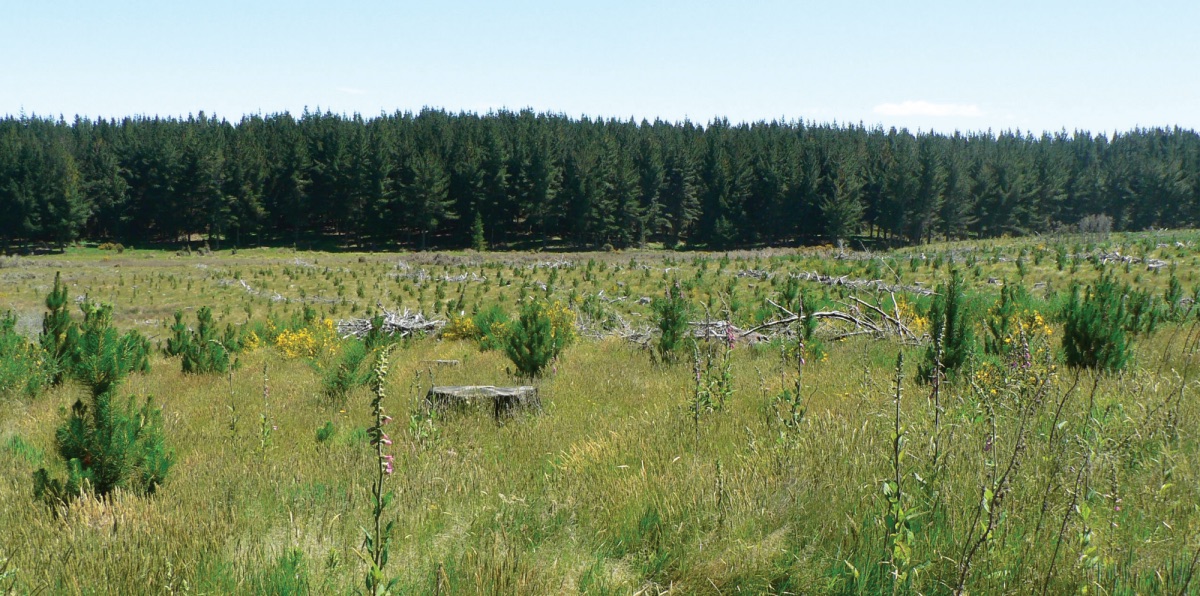
Land development
Three methods of land development were followed after we took over the homestead section. We cultivated the parts of the property which could be ploughed, and oversowed clean tussock country which was too steep to plough or too stony − a further 400 hectares. Some of this area has been converted to forestry as scrub reversion took place.
Trees were planted on the rest excluding areas of native bush. For many years we have looked at the property for places to plant trees, taking into account the soils, contour, ease of harvest, the remoteness of the area in regards to livestock shifting and yard facilities. Some forest blocks have been planted on stony areas near stock handling facilities, but while this is good for sheltering shorn sheep it has created dead areas for livestock movement.
Forest land preparation systems
Over the years a number of different site preparation methods have been tried. Originally land preparation was by bulldozer where this was necessary to remove weeds, with none required on clean stony tussock land. A gravity roller was used to crush gorse in a gully which was then burned.
Grass seed was sown, and where a hot fire ensured that gorse seed burned, it enabled radiata pine to be established. On dark faces the fire was not hot enough so radiata seedlings expired in the resulting gorse growth.
Pre-burn desiccation was also tried but persistent rain after spraying resulted in a cold fire. We tried towing a log between two tractors to smash down the heavy gorse sticks to enable planting, but again establishment was patchy.
Pre-planting desiccation of grass, fern, gorse, broom and volunteer tree seedlings has been tried. However, especially where tree seedlings are present and appropriate chemicals used, residues can cause deaths in newly planted seedlings, especially when using seedling plugs.The preferred method is now mechanical clearing by a contractor using a 12 tonne excavator equipped with root rake and running on dozer track plates. Both new and re-forested areas are wind-rowed. Manuka wind-rows are only burned if no gorse is present.
Species planted
Overall radiata pine is our bread and butter species. The multiple end uses of this tree gives it a marketing edge. Macrocarpa has potential on selected sites and Douglas fir for harder or more remote parts of the property.
Climate and altitude restricts other species. Clutha District Council classifies the planting of trees in its district scheme ‘as of right’ and is co-operative with regard to harvesting and roading. Imported disease and forest fire are the greatest threats we have.
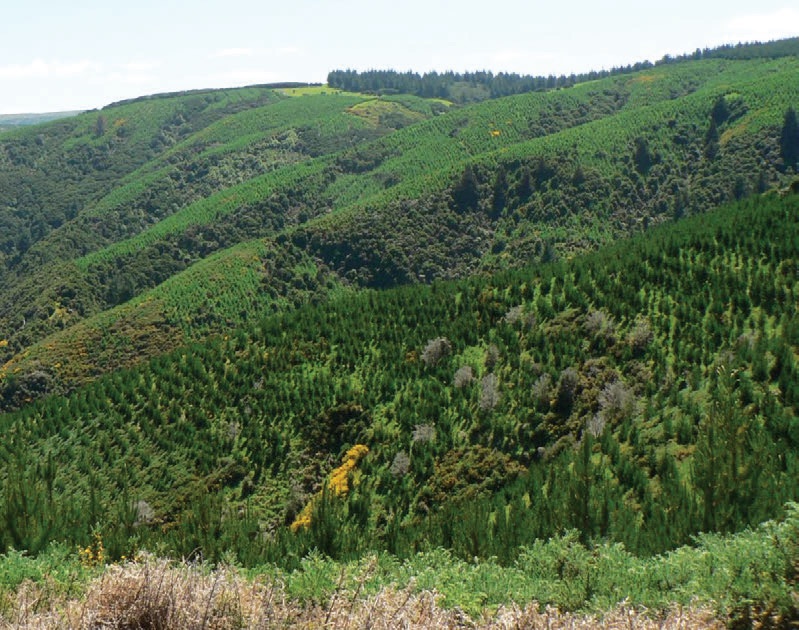
Radiata pine
Initially we planted trees using seed selected from stands of good form, then used GF17 one-year-old open grown seedlings. High GF rated seedlings can have a high incidence of nectria in the Otago and Southland area. We question whether the narrowing of the genetic base is leading to a high incidence of and susceptibility to this disease.
Radiata grows at a mean annual increment of over 25 cubic metres on this property. Multi-branched radiata suffers less from wind and snow damage. In this region a greater volume of wood, in our case around 40 per cent, is obtained in the bottom pruned logs. The wood is whiter than is often the case further north, but density is lower.
Other species
We planted two year open grown seedlings of Douglas fir initially of Longwoods origin, then Tramways. Experience has found them less prone to snow damage and gorse competition than radiata, but more palatable to sheep.
For macrocarpa we also planted two year open grown seedlings. Pruning has been undertaken on the best 250 trees to an average height of 4.5 metres. Canker is present but is not as devastating as further north.
Many eucalypts have been tried but all except E. globulus, E. johnstonii, and E. fraxinoides have succumbed to frost. Limited quantities of E. delegatensis have been sawn, with degradation from cell collapse evident.
The two year open grown seedlings of western red cedar have proved very hardy, with 100 per cent success. Although very slow growing, western red cedar is suitable for the lower parts of two-row shelter belts. We have sawn 40-year-old woodlot grown trees but the wood started to collapse within 24 hours of sawing. Kiln drying followed by steam re-conditioning may be required.
This woodlot had all the dead branches removed to six metres at age 36 and sample sawing was made to see if any wood could be used out of such young trees. Fire has since burnt the entire woodlot making assessment impossible.
Planting
When we first started planting we were warned that more tree seedlings die between the nursery beds and planting than due to any other cause. Seedlings need to be taken daily from the nursery and not left stored in a cooler for any length of time. The seedlings should be kept out of the sun and planters should only take one seedling out of the planting bag at a time. Any drying out of seedlings will cut survival rates very rapidly.
All hand planted
All trees to date have been planted by hand using planting spades. We have planted radiata at 1,666 stems per hectare at three metre by two metre spacing on areas that used to be covered with gorse and broom, with lower stocking on clean sites. A stocking rate of 1,111 stems per hectare has been used for Douglas fir, macrocarpa and eucalypts.
Seedlings grown in peat plugs have been planted at lower stocking rates as survival is better, but not many forestry companies are using these, as there are issues with sturdiness, root formation and cost. Open grown seedling survival rates range from 96 per cent for tussock country and down to 25 per cent in the worst case. This was where fire germinated considerable broom seedlings and a re-plant after a total kill spray was needed. Re-planting has been minimal over the years.
Mechanical planting
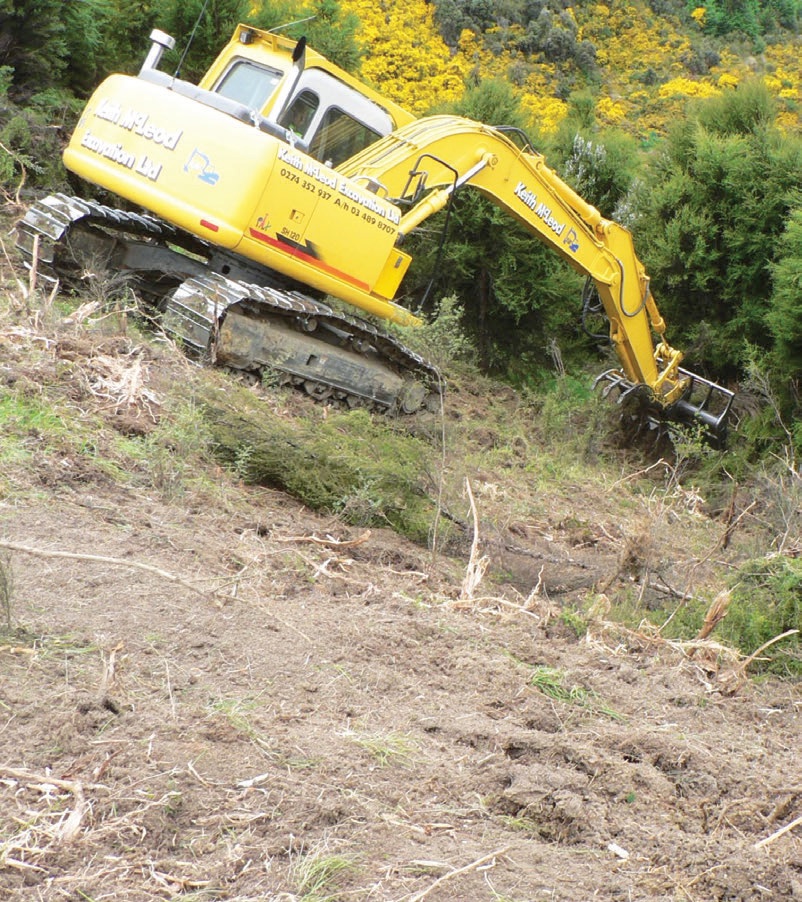
Consideration is being given to mechanical planting. Any such system will have to be able to operate on land up to 20 degrees, over rocks and slash in re-planting blocks and, of course, be cost effective. One possible machine is the Swedish Bracke Planter which we have seen operating in Scotland and is in use in Tasmania. It uses tree seedlings grown in peat plugs.
This planter is mounted on a 13 tonne excavator and injects the tree into the ground much like the Pottiputki tube hand planter. Reports from the UK Forestry Commission and the Finnish Forest Research Institute give good information about the possibilities. However root development with the plugs will need watching.
Our endeavours in agro forestry have been less than favourable. The grass under radiata plantings is of questionable quality due to shading by the trees. The return from wood came out at 40 per cent of a conventional stand next door which was planted and harvested at the same time.
Silviculture
Most of our radiata pine stands have been treated as follows −
- Pruning up to two metres on 400 stems per hectare at age five to six
- Pruning between two and four metres on 400 stems perhectare at age seven to eight
- Pruning between four and six metres on 400 stems perhectare at age nine to 10 and thin all followers.
On flat and easily rolling country we are experimenting with pruning as above but leaving all thinning to year 10. The advantages are better top branch control and thinnings that can be used as an energy source. However, the considerable disadvantages are that the stands are more prone to problem weather, loss of diameter growth and higher thinning costs if there is no market for thinning.
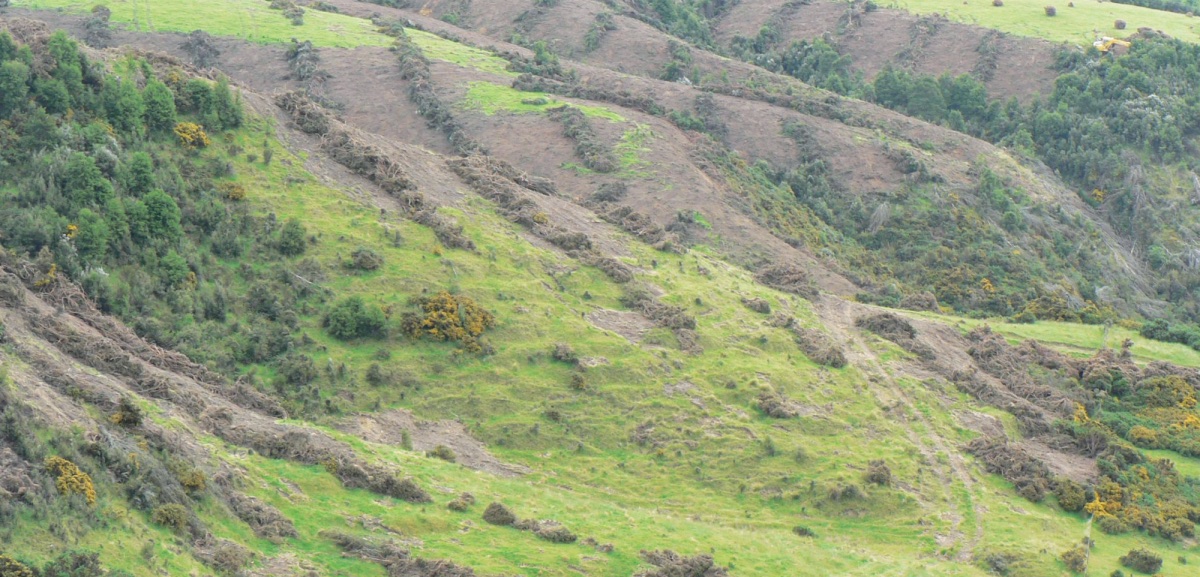
Pest problems and control
Hares and rabbits are usually controlled by night shooting. Hares are the most destructive as they will go along a row of seedlings cutting off the tops with no apparent interest in eating them. Poisoning is undertaken only if warranted.
Goats will also browse the new seedlings, consuming most of the plant. Later they ring bark the stems until the bark is too thick to be cut through. Recreational shooters tend to only control goat numbers, not reduce them, so we have had to employ professional hunters using dogs to eliminate these pests.
Deer damage is caused to young trees when deer pick on a particular tree to rub their antlers. With the decrease in deer numbers there is rarely a problem. Pigs root up the ground searching for food, but have not been a problem so far and can be controlled by recreational shooters.
Sheep readily graze young Douglas fir and have to be kept out of these blocks but we do graze radiata and Douglas fir with cattle after five years. All stock has to be excluded from macrocarpa plantings because of bark damage and possible abortion in pregnant cattle.
Beetle ring barking of new seedlngs has been severe in some second crop radiata. Our method of control is to hold off replanting for a year to allow for any population to decline. Then we windrow the slash before planting to get the feed source away from the planted seedlings.
Adverse weather
Fortunately Skilbister is rarely subject to extreme weather although we do have some problems.
Wind
Our edge trees on the windward side of a stand are subject to extra stress and deform away from the prevailing wind. In our case this is from the west. These trees produce tension wood on the windward side of the tree and compression wood on the lee side. Sawing across both zones produces severe curving of the sawn planks. Leaving extra trees on this edge can help alleviate the problem.
Wind will also dump in the middle of stands creating holes. These often enlarge with time and are impossible to avoid.
Snow
Snow damage occurs on the lee side of our forests. It is mainly caused by contour so in our case the damage is on the east side of stands, especially in the heads of gullies. It is also possible to induce this effect by planting trees at a much later date on the lee of existing stands or shelterbelts.
Complete annihilation of parts of a stand can occur and leave considerable numbers of bent growing trees. We have noticed that multi-nodal radiata withstands snow loadings better as they have shorter branches. Where silviculture is up to date, branch breakout and stem break is minimal. We now grow Douglas fir in areas prone to snow damage.
Droughts
Droughts are rare but if they occur following planting they can result in some re-planting required the next year. In a hot summer our tree growth increases. We now use boron on all trees at about age five. Overall tree health is better than past areas where no boron was applied.
Marketing and selling
I intentionally use the word marketing as in too many cases farmers use the term ‘get rid of ’ and this tells a potential buyer a lot. We have sold 15 different stands over the last 25 years.
On one occasion three stands were sold at the same time. One stand was planted by an older brother and the rest by ourselves or in a family partnership. Having potential buyers knowing what we have and an idea of volumes has paid dividends, as when they have a shortfall and need logs in a hurry, we can quickly supply. We try to have our harvesting roads available up to two years ahead to allow for the lowering of the water table. We have learned a lot and still do.
Selling a woodlot
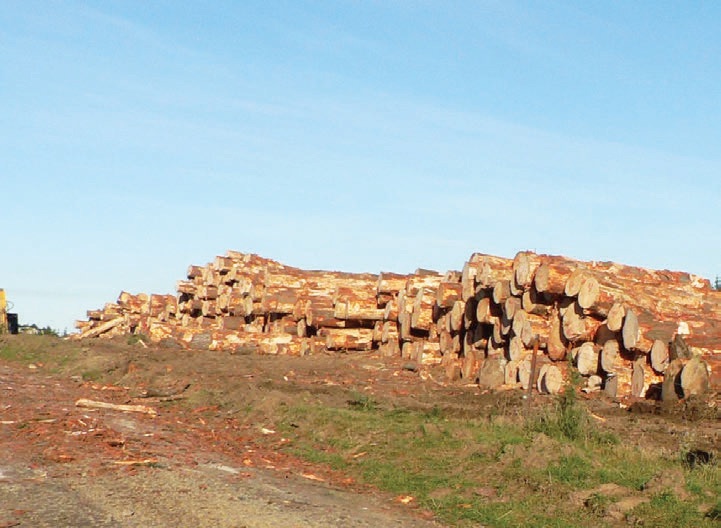
The sale of a forest stand is big business. You deserve the best price for your efforts over many years. Quite a few farm foresters quantify their forest returns on a per hectare per year basis as this allows a better comparison. The factors that influence the return are −
- The volume per hectare
- Price of each grade
- Your grade mix
- The cost of harvest including any roading and forwarding
- The distance to markets
- The cost of marketing such as commission.
You need to know what grades of logs are in your stand and possible volumes. There are people out there who specialise in doing stand inventories. Some sellers have worked their contract so the successful buyer pays for this work to save repetitive inventories.
Ask around to find a good agent − your local NZFFA branch is a good source. You could even drive around and see recent or currently harvested blocks and ask the owner what he did and what his experience was.
The logger is very important as he employs the log maker who will dictate the grades. In addition, a cheap job can cost if the slash requires an expensive clean up. Some consultants will set up a sale getting several prices and charge you for their time only.
Look carefully at the fine print of any contract, a hand shake is just not good enough. I have seen one contract document that absolved the agent from pursuing a slow payer and another that had no minimum piece size to be removed for sale. In Southland a lot of sales are on a per tonne basis. We prefer a graded sale as this has always meant we got paid for what we produced. Some buyers want to see inside your logs especially if you have poor records of pruning. One potential buyer wanted to ‘biscuit’ a pruned tree. However as we have a small sawmill we sawed the picked tree so the knotty core could be checked.
Beware of agents offering a very high price for a grade of log of which you may have little or none, to tempt you. We used to think that selling logs would be easier than selling lambs to the works. This is not so as some buyers only want a certain grade of log but often an agent is required to put all the grades to market.
Most of our radiata blocks are harvested at over 33 years. We expect to harvest Douglas fir and macrocarpa at over 50 years. Radiata is a lot more stable at older ages but it has a larger slash mass left.
The second crop
Having harvested several blocks we have found that the restocking of a harvested area has produced a different set of challenges. Soil dryness means that we have purposely held off re-planting to allow the soil moisture levels to increase before planting.
Weeds are a certainty as any logging operation will spread weed seed across a block.
On the positive side, especially for radiata and Douglas fir, the second crop grows much faster because the appropriate rhizobia are present.
Emissions Trading Scheme
We currently have 231 hectares planted before 1990, 217 hectares since 1989, with 117 hectares to be planted over the next four years with more potential forest areas. We are looking at the property’s carbon profile. Initially we have worked this out ourselves but as a check have used a consultant to verify the profile.
This profile suggests that some 6,000 carbon credits a year can be sold over the next 10 years without compromising our liabilities. Unfortunately governments cannot be trusted, as is shown by the possibility of the second round of carbon credits for pre-1989 forests not being allocated. We feel caution needs to be exercised and only moving when understanding all the implications of the ETS.
As the property is owned by a family trust several forestry rights, under legislation promoted by the NZFFA many years ago, allow family members to participate in forestry without the problems of owning their own land. Any carbon credits belong to the trust as land owner.
Getting there
We have been long time members of the NZFFA and were founding members of the Mid Otago Branch as well, members of the first South Otago Forestry Discussion Group. Travel has taken us to many of the forestry areas of the world where we have been able to compare species grown, growing conditions, harvesting techniques and processing plants. Several visits to the Elmia Forestry field days in Sweden have allowed us to compare equipment and get ideas for the small sawmill we have built on the farm.

 Farm Forestry New Zealand
Farm Forestry New Zealand